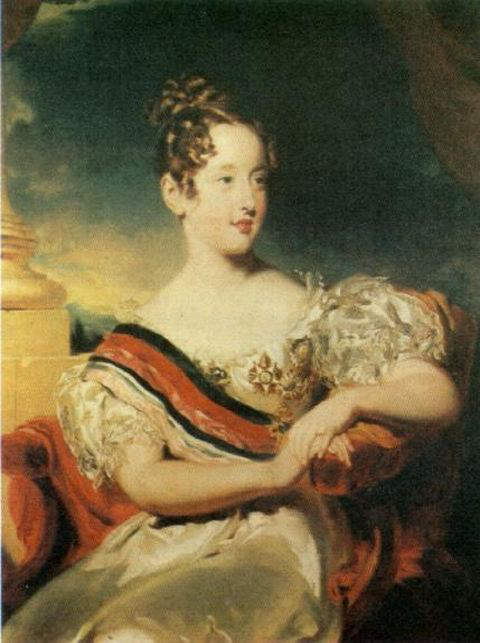History of the Discovery and Appreciation of Pearls - the Organic Gem Perfected by Nature - Page 9
Open FREE Unlimited Store Join Our Newsletter
The Use and Appreciation of Pearls by the Monarchies of the Kingdom of Portugal during the Middle Ages and until Modern Times.
In the previous webpage the use and appreciation of pearls by the monarchies of Spain from the early 16th-century until modern times were considered in detail. The monarchies considered belonged to the different dynasties that ruled Spain, such as the House of Hapsburg (1516 to 1700); the House of Bourbon (1700-1808); House of Bonaparte (1808-1813); House of Bourbon - First Restoration (1813-1868); House of Savoy (1870-1873); House of Bourbon - Second Restoration (1874-1931); House of Bourbon - Third Restoration - (1975 - to date). In the present webpage, the "History of the Discovery and Appreciation of Pearls - Page 9," the use and appreciation of pearls by the monarchies of Portugal, Spain's neighbour in the Iberian Peninsula, located in southwestern Europe, is considered in detail, from the middle ages to modern times, using the same approach as before, making use of colored portraits of the spouses of monarchs, drawn by renowned artists of the period, that gives us detailed information on the type of ornaments worn by the ladies of these royal families, not only indicating individual preferenes, but also the types and designs of jewelry most favored by them during different periods of history. As will be seen on this webpage, types of jewelry incorporating natural pearls, were quite popular among the members of the royal families during the period under conideration.
Pearls needed for the setting of these ornamments, initially came from the Orient - the Persian Gulf, the Red Sea and the Gulf of Mannar - the traditional source of pearls from time immemorial. During the 16th and 17th centuries, these important sources of pearls, particularly the Persian Gulf (1508 to 1650) and the Gulf of Mannar (1505 to 1658) were colonized by Portugal, ensuring a steady supply of pearls not only to satisfy the demand of the local pearl markets, but also for export through Portugal to other European countries. Pearls from the newly discovered pearl banks of the New World, off the Island of Cubagua in Venezuela and off the Pacific coast of Panama, exploited by the Spanish in the 16th and 17th centuries, might also have reached Portugal through Spain during this period.
The Use and Appreciation of pearls by Monarchies of the Kingdom of Portugal from 1385 to 1910.
Portugal as an independant kingdom first came into existence in 1139, after Alfonso Henrique declared Portugal independant of the kingdom of Leon, following two decisive battles, the Battle of Sao Mamede in 1128, in which he defeated his mother Countess Dona Teresa and her lover the Galician noble, Fernao Peres de Trava, becoming the sole leader of Portugal, and subsequently the Battle of Ourique on July 25, 1139, in which he defeated the Moors, who had been ruling Southern Portugal since 711 A.D., establishing himself as a powerful leader of the Iberian Peninsula, to be reckoned with. However, the recognition of Portugal as a separate kingdom from Leon and Castile, came only in 1143, after the treaty of Zamora, that established peace between the kingdom of Leon & Castile and the newly formed kingdom of Portugal. Since then the kingdom of Portugal had been ruled by a series of kings belonging to five dynasties, until the proclamation of the Portuguese Republic, on October 5, 1910. These dynasties are :- the House of Burgundy (1143-1385); the House of Aviz (1385-1580); House of Habsburg (1580-1640); the House of Braganza (1640-1834); and the House of Braganza-Saxe-Coburg & Gotha (1834-1910). This webpage considers the use and appreciation of pearls beginning with the monarchs of the House of Aviz who ruled from 1385 to 1580 until the last ruler of the House of Braganza-Saxe-Coburg and Gotha, Manuel II, "the Patriot" or "the Missed King."
Appreciation of pearls by the spouses of the monarchs of the House of Aviz (1385-1495)
The House of Aviz came into being after the dynastic crisis precipated by the death in 1383, of Ferdinand I, the last king of the House of Burgundy, founded by Alfonso Henrique. King Ferdinand I was succeeded by his daughter, Beatrice, who became the Queen of Portugal. However, her ascension to the throne of Portugal was not accepted by most Portuguese, who feared the country would lose its independance as she was married to King Juan of Castile. The people rose in rebellion and the King of Castile invaded Portugal to support his wife. The war of succession went on for two years, and finally ended in 1385, when the Castilians were defeated by the Portuguese army supported by English archers at the Battle of Aljubarrota. The Portuguese victory at Aljubarrota in August 1385, confirmed the kingship bestowed at the Cortes of Coimbra in April 1385, on John I, half-brother of Ferdinand I, the natural but illegitimate son of Pedro I. Thus Joao I (John I) the 10th-king of Portugal became the founder king of the House of Aviz, the name derived from his title, Grand Master of the Order of Aviz, conferred upon him by his father, Pedro I in 1364.
Philippa of Lancaster - Wife and Queen consort of King John I (Joao 1), king of Portugal from 1385 to 1433 and the first king of the House of Aviz
One of John I's first acts in consolidating his position as king was the signing of the Portuguese-British Alliance in 1386 against the France-Castile axis, which was further consolidated in February 1387 by his marriage to Philippa of Lancaster, the eldest daughter of John of Gaunt, 1st Duke of Lancaster and Blanche of Lancaster, the sister of king Henry IV of England. Both King John I and his Queen consort Philippa were unusually learned monarchs for the middle ages, and their love of knowledge and culture was inherited by their children, producing famous princes and princesses of Portugal, who came to be known as the "Illustrious Generation," such as Edward a writer, poet and intellectual who succeeded his father; Peter, one of the most learned and well-travelled princes of this period; and Henry, the Navigator, who guided Portugal to the great era of discoveries. John I and Philippa's marriage produced nine children, of whom six survived into adulthood.
The first act of expansion of the Portuguese kingdom, that eventually led to the colonization of lands in Africa, Asia and America, and Portugal attaining the status of a world power, began during the reign of John I, when the city of Ceuta, a vibrant trading center in Morocco, just across Gibraltar, was captured after a siege in 1415.
Philippa died of plague in 1415 at the age of 53, and John I outlived her by another 18 years dying in 1433, also of plague, at the age of 75.
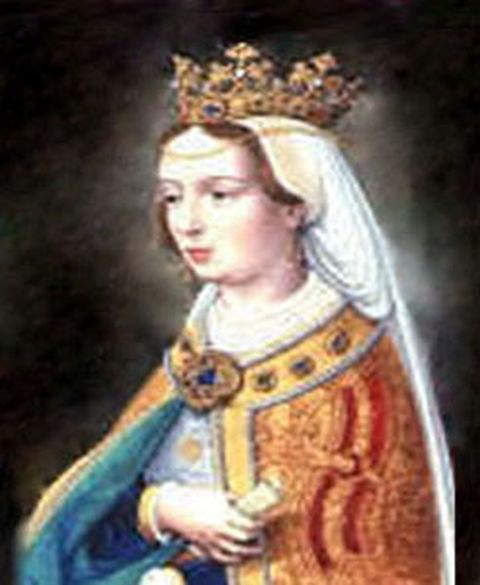
Philippa of Portugal - wife of King John I and Queen consort of Portugal
Ornaments worn -
Crown set with colored stones and pearls.
Three loops of pearls attached to her headscarf.
Central brooch and three smaller brooches on either side of it, set with colored stones and pearls.
Single row of pearls on either side of the brooches, and the midline of her robes.
Single-strand pearl bracelet and a gold bangle bracelet on her right wrist
Portrait by - Unknown artist between 1387 and 1415
Eleanor of Aragon - Wife and Queen consort of King Edward (Duarte), king of Portugal from 1433 to 1438
John I was succeeded by his eldest son Edward (Duarte), the scholar and intellectual, who showed an interest in ruling by consensus, and always consulted the Cortes on matters of crucial importance. He continued to encourage and finance the maritime exploration of Africa, under the guidance of his brother Henry, the Navigator, who founded a school of maritime navigation and initiated many expeditions. However, his downfall came when he failed to consult the Cortes before embarking on a military expedition to capture Tangiers, under the influence of his brothers Henry and Ferdinand, though two of his other brothers, Peter and John were totally opposed to it. The expedition was a disaster for the Portuguese army which was surrounded and starved into submission by the Moroccans, and to ensure a safe passage back home was forced to sign a treaty relinquishing control of Ceuta, and to leave Prince Ferdinand, the king's youngest brother as a hostage until the final handover of the city. King Edward summoned the Cortes in early 1438, for consultations, but the Cortes refused to ratify the treaty, which sealed the fate of Prince Ferdinand, who had to remain permanently in captivity in Morocco until his death in 1443. The king heartbroken over the fate of his brother, died in September 1438, of the same disease that killed both his parents, plague.
Edward as an infante and heir to the Portuguese throne married Eleanor of Aragon, the daughter of Ferdinand I of Aragon and Eleanor of Alburquerque, in 1428. The marriage produced nine children of whom five survived into adulthood. When Edward died in 1438, she became co-regent with Edward's brother Peter, the First Duke of Coimbra, for her son Afonso V, until he attained his majority. Eleanor was Edward's choice for the regency, and Peter was the people's choice for the regency. Eventually the unpopular Eleanor was forced to go into exile in Castile, and the Cortes appointed Peter as the sole regent.

Eleanor of Aragon - wife and Queen consort of Edward, king of Portugal
Ornaments worn -
In the above portrait of Queen Eleanor of Aragon, she is dressed up like a Catholic nun, and apparently she is not wearing any ornaments. However, what looks like part of an ornament, made of colored beads can be seen emerging from below her neck covering, at the bottom of the portrait.
Portrait by - Unknown Artist probably between 1433 and 1438
Isabella of Coimbra - First wife (1447-1455) and Queen consort of King Alfonso V, king of Portugal from 1438 to 1477
King Afonso V attained his majority in 1448, and assumed power from his uncle, regent and father-in-law, Infante Peter, Duke of Coimbra, on June 9, 1448. However, prior to ascending the throne Afonso seem to have fallen in love with his cousin sister, Isabella, with the blessings of her father, Peter, Duke of Coimbra, that led to their engagement in 1445 and subsequent marriage in May 1447. During his minority King Afonso V also came under the influence of another uncle, Count Afonso, the Count of Barcelona (an illegitimate half-brother of King Edward and the only ally of his mother Queen Eleanor), who was a sworn enemy of Peter, the Duke of Coimbra. The Count of Barcelona was elevated to the title of the Duke of Braganza, by the king in 1442. Duke Afonso's enmity increased after Peter's daughter married the king, and his conspiracies to alienate Peter from the king intensified. The young king, who was misled by false accusations made against Duke Peter, by the Duke of Braganza, declared Peter a rebel. This eventually led to the Battle of Alfarrobeira between the armies of King Afonso and Duke Peter, in which the king's uncle, father-in-law and former regent, Duke Peter was killed, and the duke of Braganza became the de facto ruler of the country.
The killing of the Queen consort's father did not affect the relationship of Queen Isabella with her husband the king. The couple seem to have got closer, when the king realized his mistakes, and in 1455 just before she died, she had her father honored by a grand exonerate ceremony at court, and had him reburied in a grand way. In their 8-year married life, the couple had three children, out of whom two survived into adulthood, and the youngest a son, succeeded his father as John II of Portugal.
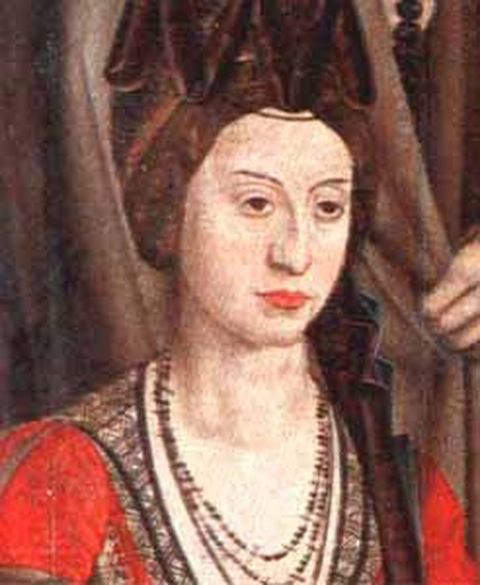
Isabella of Coimbra - First wife and Queen consort of Alfonso V, king of Portugal
Ornaments worn -
A triple-strand pearl necklace
Portrait by - Unknown artist between 1447 and 1455
Joanna of Castille (Joanna la Beltraneja) - Second wife (1475 -1481) and Queen consort of King Alfonso V, king of Portugal from 1438 to 1481
Twenty years after the death of Isabella of Coimbra, in 1475, King Alfonso V married again, taking as his wife, his niece, Joan of Castile, the daughter of his sister Joan of Portugal and King Henry IV of Castile. This marriage was actually a political move by Alfonso V, to inherit the throne of Castile as Joan was the only daughter of Henry IV and considered by some nobles as the legitimate successor to the throne of Castile, even though doubts had been cast about her paternity due to Henry IV's purported impotency. The other contender to the throne was Joanna's half-aunt, Infanta Isabella wife of Ferdinand I of Sicily, who was placed ahead of Joan of Castile in the line of succession, after King Henry IV divorced his wife Joan of Portugal in 1468 on the grounds of adultery.
When Henry IV died in 1474, the War of Castillian Succession began, with Galicia coming under the control of Joan of Castile, and the southern part of the country under the control of Queen Isabella I of Castile. It was at this point that Alfonso V decided to enter the fray in the succession crisis, and decided to marry his niece, Joan of Castile on May 30, 1475, in order to defend her right of succession and become the co-monarch of Castile. However, Alfonso V's plan went disastrously wrong, when he was defeated in the Battle of Toro, by Isabella's husband, Ferdinand I of Sicily. In 1478, Pope Sixtus IV, annuled the marriage of Alfonso V to Joan of Castile, on account of their close relationship, and she lost her titles of Infanta of Castile, Queen regnant of Castile and Queen consort of Portugal. Joan of Castile was given the choice of marrying the son of Queen Isabella when he became an adult or entering a convent. She chose the latter option entering the convent of Santa Clara in Coimbra and was later allowed to move into the Castle of Sao Jorge, where she spent the rest of her life until her death in 1530.

Joanna of Castille - Second wife and Queen consort of Alfonso V, king of Portugal
Ornaments worn -
Portrait of Joanna of Castille, probably drawn after she entered a convent, having lost her succession rights to the throne of Castile. The princess is apparently not wearing any ornaments.
Eleanor of Viseu - Wife and Queen consort of King John II, king of Portugal from 1481 to 1495
After the defeat of Alfonso V at the Battle of Toro in 1476, he went to France to seek the help of Louis XI, but returned disappointed in 1477. Totally disheartened and depressed, he then entered a state of deep melancholy and abdicated in favor of his son John II in November 1477, retiring into a monastery until his death in August 1481.
John II, took control of the affairs of the kingdom from 1477, but did not officially ascend the throne, until the death of his father in 1481. His rule initially was marked by a crackdown to curtail the power of his aristocracy and also against alleged conspirators, that led to the execution, murder or exile of most of his enemies, and total consolidation of power in his hands. His rule saw the reinvigoration of Portugal's economy and the restoration of vigorous exploratory activities along the African coast and across the Atlantic, that led to the discovery of gold in the coast of Guinea, which helped to prop up the Portuguese economy and the currency.
The most significant development pertaining to overseas exploration took place during his reign, when following the return of Columbus after the discovery of the New World in 1492, Portugal staked its claim to the newly discovered lands, that led to negotiations with Castile and the signing of the Treaty of Tordesillas on June 7, 1494, according to which newly discovered lands, west of the meridian 370 leagues west of the Cape Verde Islands, belonged to Spain and lands east of this meridian to Portugal. After the signing of this treaty Portugal's exploratory activities were mainly directed towards the East, Vasco da Gama rounding the Cape and reaching India in 1498, Pedro Alvares Cabraal discovering Brazil in 1500, Alfonso de Albuquerque conquering Goa in India, Ormuz in the Strait of Hormuz in the Persian Gulf, Point de Galle in Sri Lanka and Malacca in Malaysia between 1500 and 1510, and other Portuguese explorers landing in the port cities of China, Indonesia and Japan.
John II married his first cousin, the Portuguese infanta, Eleanor of Viseu in 1470, while he was the Prince of Portugal and heir-aspirant to the throne of Portugal. Eleanor was the daughter of Infante Ferdinand, Duke of Viseu, brother of Afonso V and his wife Beatrice of Portugal. Infante John was 15 years of age and Eleanor 12 years, at the time of their marriage. Their marriage produced two isssues, the first a son, Prince Afonso in 1475, before she ascended the throne as Queen consort of Portugal, when John II succeeded his father Alfonso V, as king of Portugal in 1481. The second child, Infante John, born in 1483 after she became Queen consort died soon after birth. Unfortunately, her only son and heir-aspirant, Infante Afonso also died in 1491, aged 16 years, in a horse riding accident, devastating both John II and the Queen. Eleanor was only one of two queen consorts of Portugal, who was not a foreigner. Her elder brother, Diogo, Duke of Viseu, and brother-in-law, Fernando II, 3rd duke of Braganza were among those who were accused of treason and executed by her husband King John II. But, ironically it was her own younger brother, Manuel I, who succeeded her heirless husband John II as the king of Portugal in 1495.
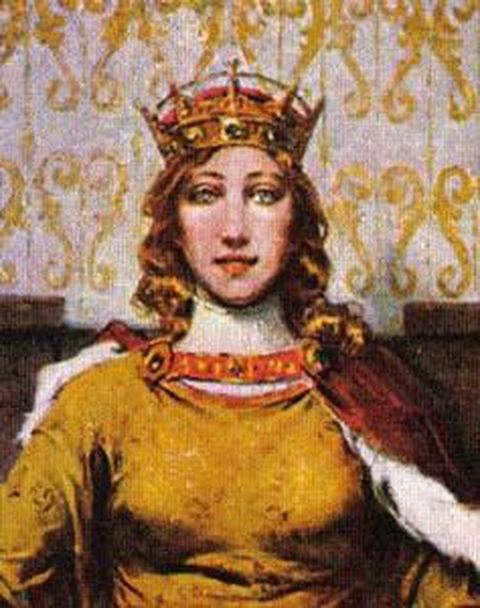
Eleanor of Viseu - Wife and Queen consort of John II, King of Portugal
Ornaments worn -
Crown set with colored stones and pearls.
Collar probably set with rows of white seed pearls.
A red band across the white collar, set with colored stones, with a hexagonal-shaped brooch at either end, set with a large colored stone.
Portrait by - Unknown artist between 1481 and 1495
Appreciation of pearls by the spouses of the monarchs of the House of Aviz-Beja (1495-1580)
Infante Manuel, the Duke of Beja, succeeded his first cousin and brother-in-law, John II, as king of Portugal in 1495. He ascended the throne of Portugal as Manuel I. Since Manuel I descended not from the main line of succession of the House of Aviz, but from Infante Ferdinand, the second surviving son of King Edward of Portugal and cadet brother of King Afonso V, he is considered by historians as the founder of a new branch of the House of Aviz, that came to be known as the House of Aviz-Beja.
Isabella, Princess of Asturias - First wife (1497-1498) and Queen consort of King Manuel I, king of Portugal from 1495 to 1521
Manuel I pursued vigorously his predecessor's policy of supporting Portuguese exploration in keeping with the Treaty of Tordesillas. It was during his reign in 1498 that Vasco da Gama, rounded the Cape and discovered the maritime route to India, that was followed by Francisco de Almeida reaching the west coast of India and Sri Lanka in 1505. Another expedition led by Alfonso de Albuquerque saw the conquering of Ormuz in the Persian Gulf, Goa in mid-western India and Malacca in Indonesia between 1500 and 1515, thus securing the monopoly of the Persian Gulf and Indian Ocean maritime routes for Portugal. Thus Portugal took full control of the lucrative spice trade originating from India and Sri Lanka. Apart from spices, other commodities that became an important part of this trans-Indian Ocean trade, were pearls, ivory, precious and semi-precious stones.
The Portuguese empire reached its height during the reign of Manuel I, attaining the status of an European and world power. Manuel I used the newly acquired wealth to build a number of royal buildings and churches and to make his court an enlightened one, by attracting leading men in the arts and sciences. A substantial part of the wealth was also used to sponsor missionaries to the new colonies.
In 1497, Manuel I married Infanta Isabella, the widowed wife of his nephew, Afonso, the Crown Prince of Portugal and heir of John II of Portugal, who died in a horse riding accident in 1491. Isabella was the eldest daughter of King Ferdinand II of Aragon and Queen Isabella I of Castile. However, Isabella extracted a heavy price from Manuel I for giving her consent to the marriage, viz. the expulsion of all Jews from Portugal, who would not convert to Christianity. Manuel I duly complied making it one of the darkest aspects of his otherwise commendable period of rule. Isabella also became the Princess of Asturias and heiress of Castile following the death of her only brother, John, Prince of Asturias. Thus, by marrying Isabella, Manuel I had the real chance of becoming the king of a united Portugal and Spain, which however did not take place as Isabella herself died during childbirth in 1498, while giving birth to her son Miguel da Paz, who became the heir to the thrones of Castile and Portugal, but died in 1500.
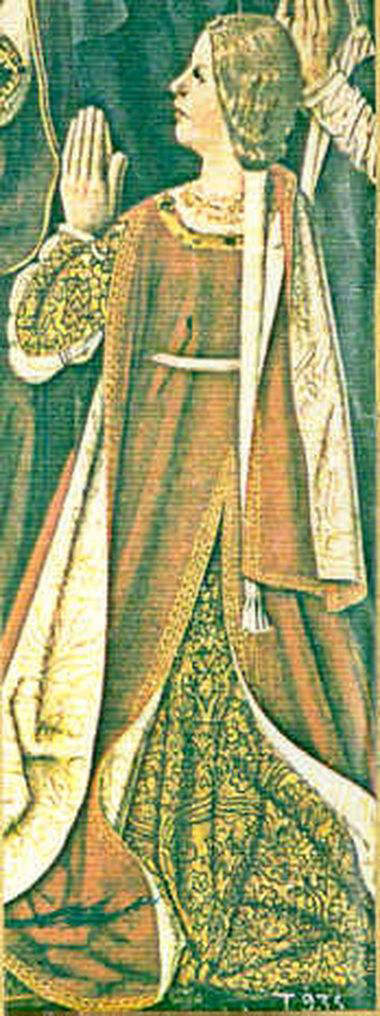
Isabella, Princess of Asturias - First wife and Queen consort of Manuel I, king of Portugal
Ornaments worn -
Multistrand necklace probably made of pearls.
Shoulder brooch set with colored stones.
Bracelets probably made of strands of pearls.
Portrait by - Unknown artist between 1497 to 1498
Infanta Maria of Castile and Aragon - Second wife (1500-1517) and Queen consort of King Manuel I, king of Portugal from 1495 to 1521
After the death of his first wife Isabella, Manuel I married Isabella's younger sister, Maria of Castile and Aragon, the third surviving daughter of Isabella I of Castile and Ferdinand II of Aragon, on October 30, 1500. The marriage turned out to be a successful one, producing 10 children, out of whom 8 survived into adulthood. The eldest son, succeeded Manuel I as the King of Portugal, assuming the title John III. The second child, Infanta Isabella married her first cousin, Charles I & V, the Holy Roman Emperor, Duke of Burgundy and King of Spain.
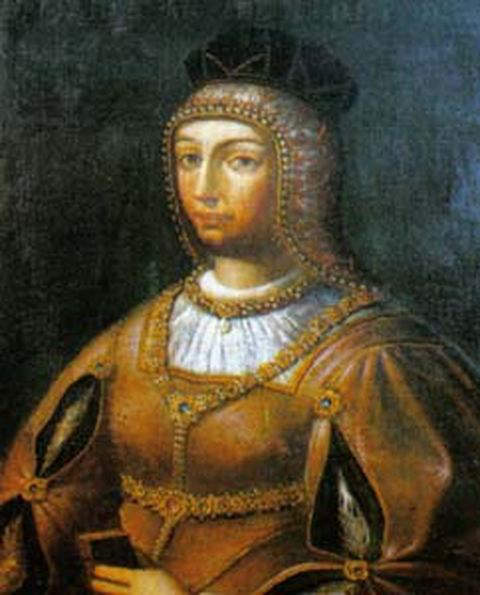
Maria of Aragon - Second wife and Queen consort of Manuel I, king of Portugal
Ornaments worn -
Head covering lined by a row of pearls.
Necklace set with groups of pearls, and a drop-shaped pearl hanging from a centerpiece.
A V-shaped broad band like a second necklace over the shoulders, connected in front to another broad band around the hip. Both bands are set with pearls and colored stones.
Brooches with a colored stone center surrounded by pearls.
Portrait by - Unknown Artist between 1500 to 1517
Eleanor of Austria - Third wife (1518-1521) and Queen consort of King Manuel I, king of Portugal from 1495 to 1521
After the death of his second wife, Infanta Maria of Castile and Aragon in 1517, King Manuel I took as his third wife, Eleanor of Austria, the eldest daughter of Philip the handsome and Joanna of Castille, and sister of Charles I & V, Holy Roman Emperor and Ferdinand I, Holy Roman Emperor. Thus, Manuel I's first and second wives, who were sisters of Joanna of Castille, were actually Eleanor's maternal aunts, and thus by marriage Manuel I was her uncle. Eleanor became the Queen consort of Portugal after her marriage to Manuel I in 1518. The marriage produced two children, out of whom one, Infanta Maria, survived into adulthood. Manuel I died of plague in 1521, and Eleanor returned to the court of her brother, Charles I in Spain. In 1530, Eleanor was married to King Francis I of France, and became the Queen of France until her husband's death in 1547.
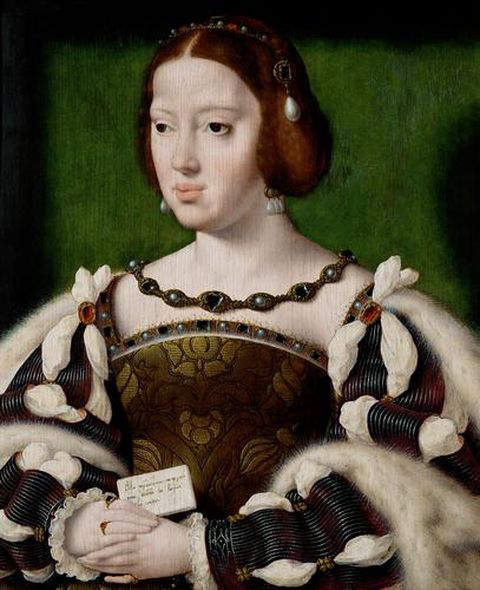
Eleanor of Austria - Third wife and Queen consort of Manuel I, king of Portugal
Ornaments worn -
Pair of earrings with three drop-shaped pearls incorporated in each earring.
Hair ornament with a large drop-shaped pearl suspended from it.
Hair band set with alternating colored stones and pearls.
Necklace set with alternating colored stones and pearls.
Neckline of bodice studded with alternating pearls and colored stones.
Bow brooch on each shoulder with a large colored stone incorporated at the knot.
Rings set with colored stones.
Portrait by - Joos van Cleve probably in 1530 after she married her second husband King Francis I of France
Catherine of Castile and Austria - Wife and Queen consort of King John III, king of Portugal from 1521 to 1557
Manuel I was succeeded by his eldest son from his second marriage to Infanta Maria of Castile and Aragon, who ascended the throne as John III. During his rule Portuguese colonization was further extended in Africa, Asia and the New World. In Africa, having colonized the western and eastern coastal regions, expeditions were undertaken to the interior of the continent. Trade between Portugal and the African colonies intensified during this period. In exchange for African gold, slaves, ivory and red pepper, the Portuguese exported salt,wheat, horses, carpets, fabric, Irish and English clothing, copper and tin vases, blades etc. to the port cities of Arguim, Mina, Mombasa and Sofala. In Asia, where Portugal had already established outposts in the Persian Gulf, the west coast of India and Sri Lanka, in Siam, Malacca, Molucca, Canton and Timor during the time of Manuel I, further contacts were made in China and Japan. The Chinese offered Macau as a reward to John III during the last days of his rule for Portuguese assistance against maritime piracy. The Portuguese arrived in Japan in 1543, and initiated trade negotiations with the Japanese, while setting up a base at Nagasaki. The setting up of trade outposts in Macau and Nagasaki also helped improve China's trade relations, mainly the silver trade with Japan. In the New World in Brazil, large scale sugarcane cultivation was started under the rule of John III, which necessitated the importation of African slaves to work these plantations, beginning from 1539. The production of sugar compensated for the decline in revenues from Asia, towards the end of the 16th-century. Evangelization and colonization went hand-in-hand as was the practice during the time of his predecessor, supported by Jesuit missionaries.
John III married his first-cousin, Catherine of Austria in February 1525, the youngest daughter of Philip the Handsome and Joanna of Castille, and sister of Charles V, Holy Roman Emperor, Ferdinand I, Holy Roman Emperor, and Eleanor of Austria. Catherine's mother, Joanna of Castile and John III's mother Infanta Maria of Castile, were sisters and the children of Isabella I of Castile and Ferdinand II of Aragon. The marriage produced nine children but only two survived early childhood - Princess Maria Manuela, First wife of King Philip II of Spain, and Prince John, who was declared heir to the Portuguese throne in 1539 and married Joan of Spain.
John III died of a sroke in June 1557. Catherine survived her husband by another 21 years, dying in February 1578, serving as the regent for her grandchild, infant king Sebastian for five years, from 1557 to 1562.
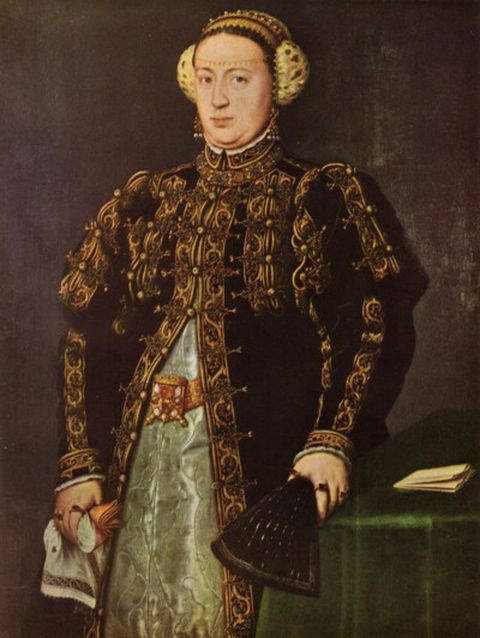
Catherine of Castile and Austria - Wife and Queen consort of John III, king of Portugal
Ornaments worn -
Headband set with pearls.
Decorative ear covering set with pearls and probably also colored stones.
Pendant earrings incorporated with three pearls in each earring.
An ornament across the forehead.
Pearls and colored stones incorporated on the collar, upper part and sleeves of the close-fitting decorative overcoat.
Belt buckle set with colored stones and pearls.
Rings set with colored stones.
Portrait by - Anthonis Mor in 1552
King Sebastian of Portugal - 1557 to 1578
Out of the two surviving children of John III, the second child Prince John was declared heir to the throne in 1539. In 1553, Prince John who was 16 years married his first cousin Princess Joan of Spain, youngest daughter of Charles I & V of Spain and Isabella of Portugal, and sister of future Philip II of Spain. However, Prince John died of Juvenile diabetes on January 2, 1554 and 18 days after his death the Princess gave birth to John's pothumous son, Prince Sebastian. Since his birth occurred just two weeks after the death of his father and heir to the throne, Sebastian was born heir to the throne of Portugal, after his grandfather. The name Sebastian was derived from the day on which the prince was born, viz. St. Sebastian's day which fell on January 20, 1554. When King John III died on June 11, 1557, three-year old Sebastian succeeded to his grandfather's throne, with his grandmother, Catherine of Castile and Austria, serving as regent, for the first five years and later his great uncle, Cardinal Henry of Evora, until he attained his majority in 1568.
Growing up and educated under the guidance of Jesuit priests, King Sebastian turned out to be a devout and enlightened king, achieving a great deal during his short period of rule that lasted just 10 years from 1568 to 1578, such as introducing adminisrative, judicial and military reforms; creating a scholarship programme for deserving students who wished to read medicine and pharmacy in the University; compiling all laws of the kingdom into a collection that came to be known as Sebastian's code; establishing a system of measurement for liquid and solid products; setting up communal granaries that helped poor farmers at times of low yields, giving credit, lending seeds and commodities to be paid back with farm products after successful harvests; improving cosmography teaching for sea pilots that decreased the number of ship wrecks; regulating the law courts to minimize delays in the dispensation of justice; fighting the great plague of Lisbon in 1569 by bringing in doctors from Seville to assist the Portuguese doctors, creating two hospitals in Lisbon to take care of people afflicted with the plague, and creating institutions to lookafter widows and orphans of those killed by the plague.
In 1576, as various marriage plans were under consideration for the young Sebastian to get married, a succession struggle in neighboring Morocco led to the incumbent Sultan Abu Abdallah Mohammed II Saadi seeking refuge in Portugal and asking for Sebastian's help in defeating his Turkish-backed uncle, Abu Marwan Abd al-Malik I Saadi who had usurped his throne. Sebastian sought help from Philip II of Spain, which was turned down, and then in 1578, embarked on his own with 17,000 troops who sailed to Morocco and joined 6,000 Moorish troops of Sultan Abu Abdallah. Against the advice of his commanders Sebastian then moved at the head of his joint army to the interior, where the two opposing armies met and at the "Battle of Alcacer Quibir" that followed. The Portuguese army was routed by the numerically superior army of Sultan Abd al-Malik, and King Sebastian was killed in the battle.
Cardinal-King Henry of Portugal - 1578 to 1580
With the death of the heirless king on August 4, 1578, his greatuncle Cardinal Henry of Evora, younger brother of King John III, who was previously his regent, ascended the throne of Portugal. Cardinal Henry renounced his clerical offices and sought to take a bride for the continuation of the Avis dynasty. However, Pope Gregory XIII did not release him from his vows, and Cardinal-King Henry died on January 31, 1580 without a successor, and not having appointed a Regency Council to choose a successor.
Appreciation of pearls by the spouses of the monarchs of the House of Habsburg of Portugal, also known as the Philippine dynasty (1580-1640)
As the last two kings of the House of Aviz-Beja, King Sebastian and King Henry died without heirs, the royal house of Aviz-Beja came to an end with their deaths. Soon after this, three grandchildren of King Manuel I, the founder of the House of Aviz-Beja, claimed the throne of Portugal. They were Infanta Catarina, Duchess of Braganza, Philip II of Spain and Antonio, Prior of Crato. Antonio was King Manuel I's grandson in direct male line, through his son, Prince Louis, Duke of Beja, but he was illegitimate, making his claim inferior to that of Philip II and Catherine, Duchess of Braganza. Yet on July 24, 1580, Antonio who was supported by the lesser clergy, peasants and artisans, proclaimed himself King of Portugal and was acclaimed as king in many cities and towns throughout the country. Even though Philip II of Spain descended from Manuel I through his daughter Isabella who married Charles I & V of Spain, the Holy Roman Emperor, his claim was supported by the Council of Governors of Portugal, the nobility and the gentry, who escaped to Spain and declared Philip II the legal successor of Henry. Philip II then ordered Spanish Habsburg armies led by Fernando Alvarez de Toledo, the Duke of Alba to enter Portugal, where they defeated Prior Antonio's troops in the Battle of Alcantara, on August 25, 1580. Prior Crato escaped to the Azores, where he established an alternative government that lasted until 1583. Philip II was recognized as king by the Cortes of Tomar, and crowned Philip I of Portugal on March 25, 1581, heralding the beginning of a 60-year personal union under the rule of the Spanish House of Habsburg. Philip II stayed in Lisbon until 1583, and left for Madrid appointing his nephew Albert of Austria as his Viceroy in Lisbon. In Madrid, he established a separate Council of Portugal to advise him on Portuguese affairs, and gave excellent positions to Portuguese nobles in Spanish courts. Spain ruled Portugal under a system known as "personal union" alllowing Portugal to maintain autonomous law, currency and government.
The three monarchs of the House of Hapsburg of Spain, who ruled Portugal under the system known as personal union were :-
1) Philip II of Spain - Philip I of Portugal, grandson of Manuel I, from March 25, 1581 to September 13, 1598.
2) Philip III of Spain - Philip II of Portugal, son of Philip I of Portugal, from September 13, 1598 to March 31, 1621.
3) Philip IV of Spain - Philip III of Portugal, son of Philip II of Portugal, from March 31, 1621 to December 15, 1640.
The appreciation of pearls by the spouses of Philip II, Philip III and Philip IV of Spain was considered in detail in the previous webpage - History of the Discovery and Appreciation of Pearls - page 8
Appreciation of pearls by the spouses of the monarchs of the House of Braganza from 1640 to 1834.
Even though Portugal was ruled by Spain as a separate kingdom, by the Council of Portugal, consisting exclusively of Portuguese nobles, that kept its vast empire in Asia, Africa and the New World to itself, maintining its own laws, administration, flag, currency, taxes and army and also its own ambassadors, the Portuguese nobility left behind in Portugal, enjoying less privileges than their counterparts serving in the Council of Portugal in Madrid, who were very rich and powerful, felt that Portugal did not have the political and economic strength that it would have normally possessed, had it been a sovereign and independent state. This was clearly seen in the Dutch occupation of northern Brazil, which Portugal was not able to prevent despite military support by the overstretched Spanish army, which had to lookafter its own domains in the vast Spanish empire. Moreover, the joining of the two crowns, denied Portugal of its independent foreign policy and led to unintentional involvement in wars, such as the Eighty-years War being waged in Europe at the time between Spain and the Netherlands, that not only led to a deterioration in relations with England, Portugal oldest ally, but also started a new war with the Netherlands from 1595 to 1663, in the Portuguese empire overseas in Africa, Asia and Brazil, that led to Dutch companies invading Portuguese colonies and the loss of Portugal's dominance of the Indian Ocean trade routes. The cumulative effect of all these disadvantages, led John IV to spearhead an uprising against Spanish rule, that began on December 1, 1640, supported by disgruntled nobles and the general population, leading to proclamation of John IV as king, and marking the end of the 60-year period of Iberian Union.
Luisa of Guzman - Wife and Queen consort of King John IV, king of Portugal from 1640 to 1656
The ascension of John IV as the King of Portugal, marked the beginning of the rule of a new dynasty in Portugal, known as the House of Bragnza or Brigantine dynasty, that ruled Portugal from 1640 until the abolition of the monarchy in 1910. The duchy of Braganza was created in 1442 by King Afonso V, who appointed his uncle, the Count of Barcelona (an illegitimate half-brother of King Edward) as the first Duke of Braganza. John IV was the grandson of Catherine, the Duchess of Braganza, a granddaughter of Manuel I, who was a claimant to the Portugal throne in 1580, at the time when the last king of the House of Aviz-Beja died without an heir. John IV, the 8th Duke of Braganza, and the great great grandson of Manuel I, was considered as the legitimate heir to the throne, during the rule of Philip III of Portugal. His accession to the throne, led to a protracted war with Spain, that only ended with the recognition of Portuguese independence in 1668. During his reign, Portugal lost the colonies of Malacca (1641) and Sri Lanka (1656) to the Dutch, and Muscat (1650) to the Sultan of Oman, but successfully recovered Luanda from the Dutch in 1648 and most of Brazil from the Dutch in 1654.
In 1633, when he was the Duke of Braganza, John IV married Luisa de Guzman, the eldest daughter of Juan Manuel Perez de Guzman, the 8th Duke of Medina Sidonia. The marriage produced 7 children, out of whom 5 survived into adulthood. Two of her sons, Alfonso VI and Pedro II would subsequently become kings of Portugal, and her daughter Catherine of Braganza who married Charles II, would become the queen of England. After John IV's death in 1656, she became the regent of the kingdom, during her son, Alfonso VI's minority, and continued in this capacity even after her son became an adult, due to his mental instability, until 1662.
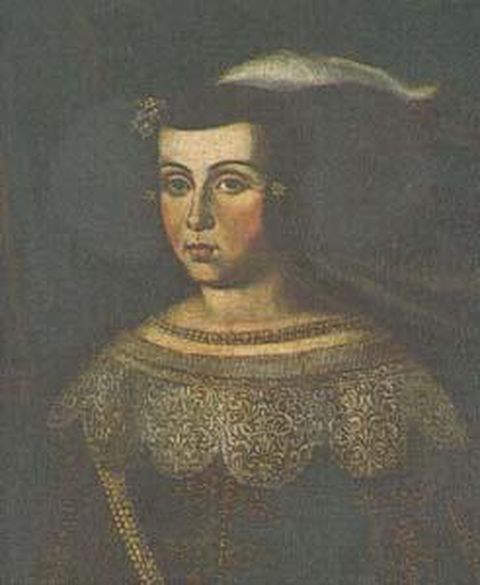
Luisa of Guzman - Wife and Queen consort of John IV, king of Portugal
Ornaments worn -
Head ornament set with pearls.
Ear ornaments set with pearls.
Double-strand of pearls across the shoulders.
Four-strand pearl band extending diagonally across her dress from the right shoulder.
Portrait by - Unknown artist
Maria Francisca of Savoy - wife of Alfonso VI and Queen consort of Portugal from 1666 to 1668 and later first wife(1668-1683) of Peter, Prince regent and Queen consort of Portugal for second time from September 1683 to December 1683
Alfonso VI as a young child of three years suffered an illness that left him paralyzed on the left side of his body and mentally unstable. He ascended the throne of Portugal in 1656, after the death of his father, with his mother, Luisa serving as his regent, and continuing in this capacity even after he became an adult, due to his mental and physical disabilities. During his mother's regency, Portugal lost control of Jaffnapattanam, the last outpost in Sri Lanka, to the Dutch in 1658. In 1661, when Afonso VI's sister, Catherine of Braganza married King Charles II of England, two Portuguese outposts, Tangiers in Morocco and Bombay in India was ceded to the British as dowry for the marriage. Again British mediation in 1661, led to Netherlands acknowledging Portuguese control of Brazil, in return for uncontested control of Sri Lanka.
In 1662, a palace intrigue saw the physically and mentally weak Alfonso VI taking control of his government, and his mother Luisa being confined to a convent. In 1666, the nobles who wielded power on his behalf, got Alfonso VI married to Maria Francisca, the daughter of the Duke of Savoy. However, the marriage would not last long, and Maria Francisca filed for an annulment in 1667, on the grounds of impotence of the king.The Church granted her the annulment after which she married Afonso's younger brother, Pedro, the Duke of Beja in 1668. In the same year Pedro and Maria Francisca gained enough support to force King Alfonso VI to relinquish control of the government, and Pedro became the Prince regent in 1668. King Alfonso was exiled to the island of Terceira in the Azores, where he spent the rest of his life, returning to mainland Portugal only in 1683, shortly before he died in September of that year.
After her marriage to Pedro in 1668, Maria Francisca gave birth to a daughter in 1669, named Isabel Luisa Josefa, who became the Princess of Beira. She was not able to produce any more children after this. When King Afonso VI died in September 1683, his brother, the Prince regent Pedro ascended the throne as Pedro II of Portugal, and Maria Francisca became the Queen consort of Portugal for a second time, but died just three months afterwards in December 1683.

Maria Francisca of Savoy - Wife and Queen consort of Alfonso VI (1666-1668) and later first wife of Pedro (1668-1683) and Queen consort of Portugal from September 1683 to December 1683
Ornaments worn -
Double-strand pearl necklace.
Shoulder brooch set with colored stone and a large drop-shaped pearl.
A second brooch consisting of four large spherical pearls just below the right shoulder.
Pearls embroidered on the bodice of her dress.
Pearl bracelet.
Portrait by - Unknown artist
Maria Sofia of the Palatinate - Second wife (1687-1699) and Queen consort of Pedro II (Peter II), king of Portugal from 1683-1706
Four years after the death of his first wife, Pedro II married again, taking as his second wife Maria Sofia of Neuburg, the daughter of Philip William, Elector Palatine and Elisabeth Amalie of Hesse-Darmstadt. Maria Sofia was 21 at the time of her marriage. The marriage produced 7 children out of whom five survived into adulthood, the eldest John, succeeding his father, as John V of Portugal. As Queen of Portugal, Maria Sofia was involved in charities, supporting widows and orphans, and even allowing poor patients access to medical care at the royal palace. She died in 1699 at the age of 33 years. Her husband Pedro II outlived her by another 7 years, dying in 1706 at the age of 58.

Maria Sofia of the Palatinate - Second wife and Queen consort of Pedro II, king of Portugal
Ornaments worn -
Single-strand pearl necklace.
Portrait by - Unknown artist
Maria Anna of Austria - Wife and Queen consort of John V, king of Portugal from 1706 to 1750
When Pedro II died on December 9, 1706, he was succeeded by his 17-year old eldest son, the Prince of Brazil, John, who ascended the throne as John V of Portugal. His first act as king was to announce his adherance to the Grand Alliance of Great Britain, Portugal and Austria, which his father Pedro II had joined in 1703, during the War of Spanish Succession (1702-1715). John V's rule lasted for 44 years, until 1750, a period during which Portugal became one of the wealthiest nations in Europe, thanks for the discovery and exploitation of gold, diamond and precious gemstone mines of Brazil. It was esimated during this period, that within a few decades, Portugal collected more gold from the newly discovered Brazilian mines, than Spain took elsewhere in Central and South America over 400 years. A fifth of each ton of gold extracted from these mines went to the Crown of Portugal. Likewise the crown also had a share in the diamonds and gemstones mined in Brazil. The affluence of the crown, made it unnecessary for the king to consult the Cortes, and John V became one of the most powerful and absolute monarchs of Europe. The increased affluence also enabled the king to build his own version of the Versailles, the Grand Royal Palace of Mafra; patronize the arts, putting together one of the greatest collections of paintings at that time, attributed to the most reputed artists of the period; expanding the libraries in Portugal, such as the music library and the royal library; patronize the intellectuals by creating royal academies; and above all boosting the country's economy by creating mnufacturing industries all over the country. He adopted a prudent foreign policy for Portugal, remaining politically neutral in European conflicts, and directing his energies to gain the recogntiion of the Vatican for Portugal as a lawful and sovereign country, which came in 1748 during the reign of Pope Benedict XIV.
Two years after he ascended the throne, John V married his maternal first cousin, Archduchess Maria Anna of Austria, daughter of Leopold I, Holy Roman Emperor, and his third wife Eleonore Magdalena of Neuburg. The marriage produced six children, out of whom three survived into adulthood. The second surviving child, Joseph succeeded his father as Joseph I of Portugal, and the third surviving child, Peter, became the King Consort of Portugal after marrying his niece, Queen Maria I of Portugal.
In 1742, Maria Anna was appointed as regent to her husband John V, who suffered a stroke that left him partially paralyzed. She served in this capacity until her son, Joseph I ascended the throne of Portugal in 1750, after the death of her husband.
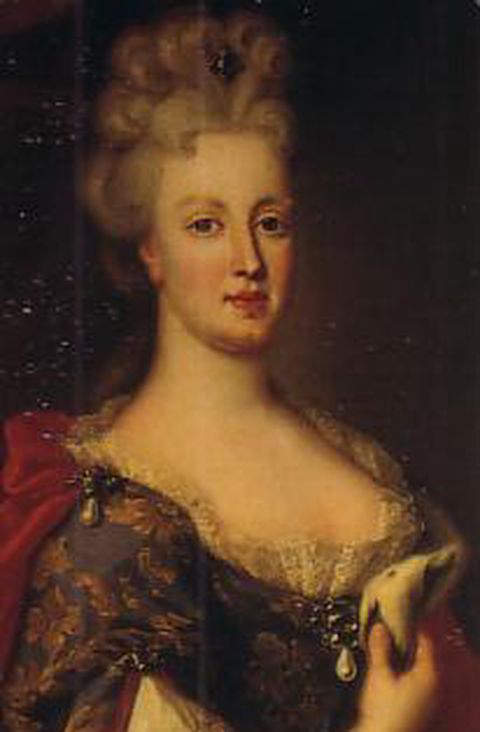
Maria Anna of Austria - Wife and Queen consort of John V, king of Portugal
Ornaments worn -
Stomacher set with colored stones and pearls and a large drop-shaped pearl suspended from it.
Shoulder brooch with colored stones and a large drop-shaped pearl suspended from it.
Head ornament set with colored stones.
Portrait by - Unknown Artist

Queen Maria Anna of Portugal in her later years
Ornaments worn -
Head ornament set with pearls.
A second head ornament set with colored stone and pearls.
Pearl drop-earrings.
Stomacher set with pearls.
Three-strand pearl bracelet.
Band around hip set with pearls and colored stones.
Portrait by - Unknown artist
Mariana Victoria of Spain - Wife and Queen consort of King Joseph I, king of Portugal from 1750 to 1777
After the death of John V on July 31, 1750, his eldest surviving son, ascended the throne as Joseph I of Portugal. Joseph was 36 years old at the time he ascended the throne.
In 1729, at the age of 15, Joseph, the Prince of Brazil, married Infanta Mariana Victoria of Spain, daughter of Philip V of Spain and Elizabeth Farnese. This was part of a double-marriage that also saw Joseph's elder sister Barbara of Portugal marrying Mariana Victoria's elder half-brother, Ferdinand, the Prince of Asturias, the future Ferdinand VI of Spain. The marriage produced four surviving dughters, of whom the eldest Infanta Maria, became the Princess of Brazil and heiress to the throne, and succeeded Joseph I as the Queen regnant of Portugal. During the last stage of his rule, Joseph I suffered from a series of strokes, that left him totally incapacitated, and Mariana Victoria was appointed regent for her husband in November 1776 and served in that capacity until his death on February 24, 1777.
The reign of Joseph I, saw the rise to power of the Marquis of Pombal, Sebastiao de Melo, the former Portuguese ambassador to London, in whose hands effective power was placed by the king. The Marquis structured the economic, social and colonial policies of Portugal, to make it a more efficient contender among other powers of Europe. Joseph and Pombal's reign also saw the greatest natural catastrophe to hit Portugal in its history, the Lisbon earthquake of November 1, 1755, followed by a tsunami and fire, in which nearly a 100,000 people lost their lives. As a result of the earthquake Joseph I, became claustrophobic and ordered the movement of the royal palace to the hills of Ajuda, where an extensive complex of tents were built. The Marquis of Pombal, who survived the earthquake, immediately embarked on rebuilding the city, which began less than an year after the catastrophe. The reconstruction and rehabilitation of Lisbon led to the research and designing of buildings that could withstand subsequent earthquakes. Following an attempted assassination of Joseph I in 1758, in which the country's aristocracy was implicated, the Marquis of Pombal cracked down hard on those involved, showing no mercy and prosecuting and executing every one involved and their families, including women and children, and also expelling the Jesuits who controlled education and large extents of Church lands. Following this incident the power of the aristocracy was broken, and the Marquis effectively ruled Portugal, without any opposition, until Joseph I's death in 1777.
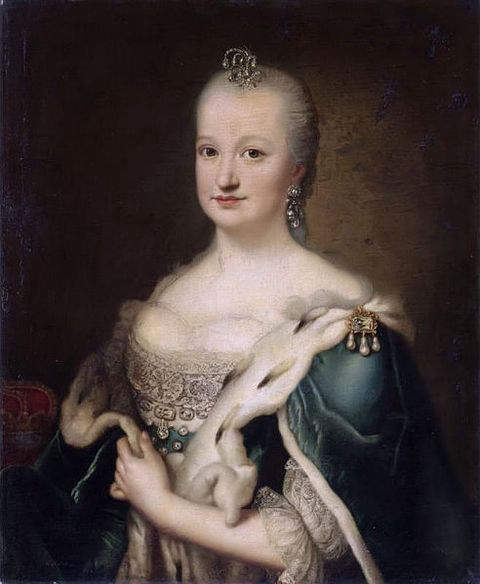
1735-Portrait of the Princess of Brazil, Mariana Victoria - Wife of Joseph, Prince of Brazil, heir to the Portuguese throne
Ornaments worn -
Hair ornament set with pearls.
Pendant-earrings incorporating three drop-shaped pearls.
Shoulder brooch with three drop-shaped pearls.
Stomacher with single drop-shaped pearl, surrounded by several spherical pearls embroidered on the dress.
Portrait by - Johan Georg Ziesenis around 1735.
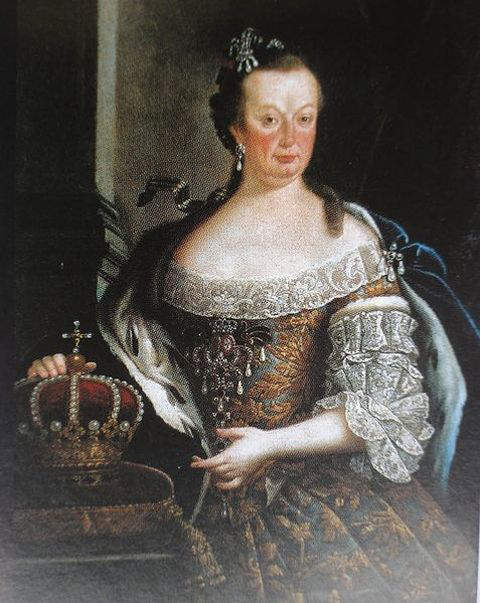
Mariana Victoria of Spain - Wife and Queen consort of Joseph I, king of Portugal
Ornaments worn -
Head ornament incorporating three drop-shaped pearls.
Drop-earrings with single drop-shaped pearl.
Shoulder brooch with three drop-shaped pearls.
Elaborate stomacher incorporating pearls, colored stones and several drop-shaped pearls.
The Queen is depicted placing her right hand on the crown set with pearls and colored stones.
Portrait by - Miguel Antonio do Amaral around 1760
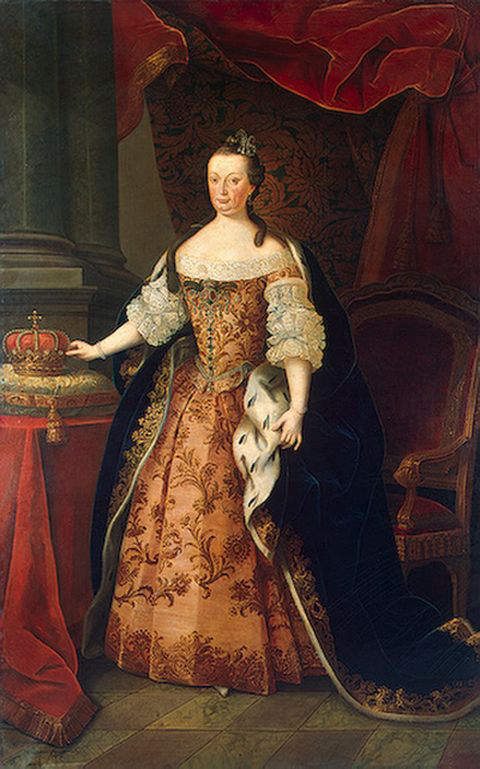
Portrait of Queen Mariana Victoria painted around 1773
Ornaments worn -
Same head ornament as the preceding portrait incorporating three drop-shaped pearls.
Drop-earrings with single drop-shaped pearl.
Stomacher set with pearls.
Belt incorporating pearls and a drop-shaped pearl in front.
Bracelet on each wrist (details cannot be identified).
The Queen is shown placing her right hand on a crown set with pearls and colored stones.
Portrait by - Miguel Antonio do Amaral around 1773
Queen Maria I of Portugal - The first Queen regnant of Portugal, Brazil and the Algarves, who ruled from 1777 to 1816
Joseph I had no surviving male issue, and only four surviving daughters. His wife Mariana Victoria also gave birth to two stillborn sons and one stillborn daughter and had a miscarriage in 1750. All his children were born before he ascended the throne on the death of his father, on July 31, 1750. One of his first acts after ascending the throne was to proclaim his eldest daughter Maria Francisca as the Princess of Brazil and official heiress to the throne, perhaps knowing very well that the Queen consort would not be able to bear anymore children.
Maria Francisca, ascended the throne of Portugal as its first Queen Regnant, Maria I, on the death of her father, Joseph I on February 24, 1777. Both Queen Maria I and her mother Mariana Victoria had developed a hatred and dislike towards the Marquis of Pombal, because of his overpowering influence on Joseph I, and the ruthlessness displayed by him against the Tavora family, who were implicated in the assassination attempt. Thus, after ascending the throne, one of the first acts of Queen Maria I, was to relieve Pombal I of all his political offices, and forbid him from coming within 20 miles of Lisbon, effectively exiling him to the country side and curtailing his influence. Pombal retired to his estate where he died peacefully in 1782. During the first four years of her rule, Queen Maria I, came under the influence of her mother Mariana Victoria, to whom she often turned for advice on most matters of state. Mariana Victoria died in 1781, after which she ruled on her own, possibly in consultation with her husband and co-monarch Peter III of Portugal.
Maria I married her father's younger brother, Infante Peter, on June 6, 1760, when she was the Princess of Brazil and heiress to the throne of Portugal. Maria was 25 and Peter 43 at the time of their marriage. Despite the difference in their ages, the marriage turned out to be a successful one producing six children, out of whom three survived into adulthood. After the marriage, Peter was referred to as the Prince of Brazil, and when Maria I ascended the throne as Queen of Portugal, Peter became the co-monarch and King Consort of Portugal, by virtue of his marriage to the Queen regnant, and came to be known as Peter III of Portugal. However, Peter III made no attempt to takepart in the affairs of the government, instead prefering to spend his time hunting or in religious exercises.
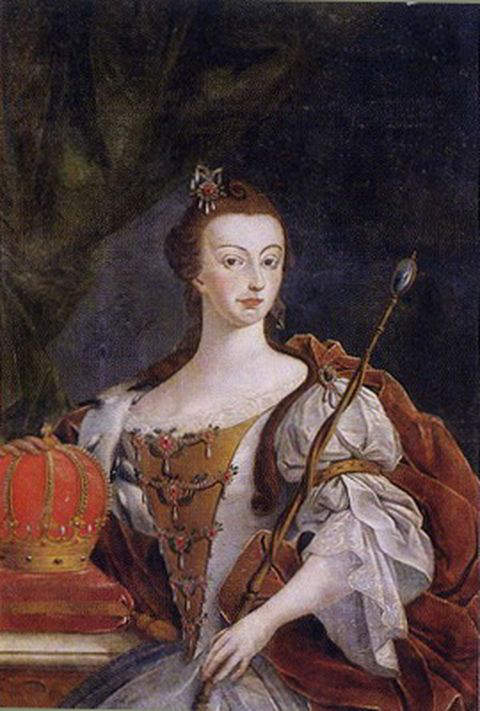
Queen Dona Maria I of Portugal - First Queen regnant of Portugal
Ornaments worn -
Head ornament with pearls and colored stones, and six drop-shaped pearls.
A vertical row of five brooches, decreasing in size from the second largest brooch downwards. Each brooch has a central large colored stone, surrounded by a row of pearls, and a large drop-shaped pearl suspended from below. The central brooch is connected to two smaller brooches on either side by a short loop of pearls. Drop-shaped pearls are also suspended from below the smaller brooches.
The Queen is placing her right hand on the Crown of Portugal, also set with colored stones and pearls.
Portrait by - Jose Leandro de Carvalho between 1800 and 1816
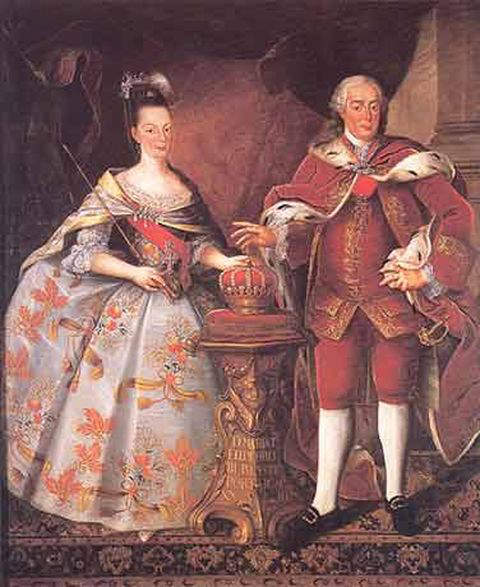
Queen Dona Maria I of Portugal with her uncle and husband Pedro III
Ornaments worn by the Queen -
Head ornament with several drop-shaped pearls.
A pearl brooch with three drop-shaped pearls, that secures the ends of the cloak, around the Queen's shoulders.
The Queen is placing her left hand on the Crown of Portugal, set with colored stones and pearls, symbolizing her authority.
Ornaments worn by King Pedro III
The cloak around Pedro III's shoulders is also secured by a brooch set with pearls
The King is not placing his hand on the crown, symbolizing where royal authority actually lies.
Portrait by - Unknown artist between 1800 and 1816
Charlotte of Spain (Carlota Joaquina)- Wife and Queen consort of John VI, king of Portugal from 1816 to 1826
Queen Maria I became mentally unstable beginning from 1786, the first manifestations of the disease being religious mania and melancholia. Her sickness worsened after the death of her husband in 1786, followed by her eldest son, Infante Jose, Prince of Beira who died of smallpox in 1788 and the death of her confessor in 1791. In 1792 she was treated for insanity by the English physician Francis Willis, who had previously treated George III of the United Kingdom. In 1792, Infante John, the Prince of Brazil and heir to the throne, took over the affairs of the government in his mother's name and in 1799, took the title of Prince Regent of Portugal. During the Franco-Spanish invasion of Portugal in 1807, at the urging of the British government the entire royal family of Portugal including the ailing queen, fled Portugal to Brazil where they set up a Cortes-in-exile, where Infante John continued to rule in his mother's name. In 1815, the regency government led by Infante John, elevated Brazil to the status of a kingdom and Maria I was proclaimed the Queen of the United kingdom of Portugal, Brazil and the Algarves. After Napoleon was defeated in 1815, the royal family continued to stay in Brazil, where Queen Maria died in 1816 in Rio de Janeiro, at the age of 81.
After the death of the Queen on March 20, 1816, the Prince Regent, John, ascended the throne as King John VI of Portugal and Brazil, but continued to reside in Brazil, instead of returning to Portugal. The absence of the royal family from Portugal caused dissatisfaction, that led to the peaceful revolution of August 24, 1820, and the proclamation of a constitutional government to which John VI had to swore fidelity, on his return to Portugal in 1821. In the same year and again in 1823, John VI had to suppress a rebellion by his younger son, Miguel, whom he was compelled to banish in 1824. In September 1822, his eldest son Peter, declared Brazilian independence and proclaimed himself Emperor Peter I of Brazil. John VI refused to recognize Brazilian independence until 1825, when he restored Peter to the succession in the belief that Brazil and Portugal would be re-united after his death. John VI died in Lisbon on March 26, 1826.
John VI married Charlotte of Spain in 1785, the eldest surviving child of King Charles IV of Spain and his wife Maria Luis of Parma. The marriage officially took place in 1785, but was consummated only in 1790 in Lisbon. In 1788, when Joseph, Prince of Brazil and John's elder brother died, John became the heir to the throne of Portugal, and received the title Prince of Brazil and Charlotte was known as the Princess of Brazil. The marriage produced nine children, between between 1793 and 1806, out of whom eight survived into adulthood. The eldest son Peter, proclaimed the independence of Brazil in 1822, and became its first monarch, as Emperor Peter I, and succeeded his father as King of Portugal in 1826, as Peter IV. A daughter, Infanta Isabel Maria, served as the Regent of Portugal from 1826 to 1828, and the younger son Miguel became the king of Portugal from 1828 to 1834.
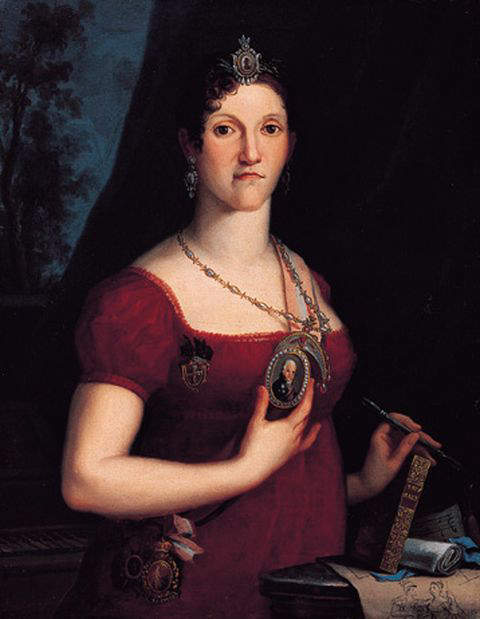
Charlotte of Spain - Wife and Queen consort of John VI, king of Portugal
Ornaments worn -
Head ornament with miniature surrounded by pearls.
Drop-earrings with colored stones and pearls.
Necklace with pearls and colored stones.
Brooch with miniature of King John VI, surrounded by a single row of pearls.
Second brooch with miniature on the right side of her hip.
Portrait by - Unknown artist

Carlota Joaquina wearing panniers - Portrait painted before her marriage while an infanta of Spain
Ornaments worn -
Elaborate headdress
Dress expanded by panniers, probably studded with colored stones and pearls.
Portrait by - Mariano Salvador Maella around 1785
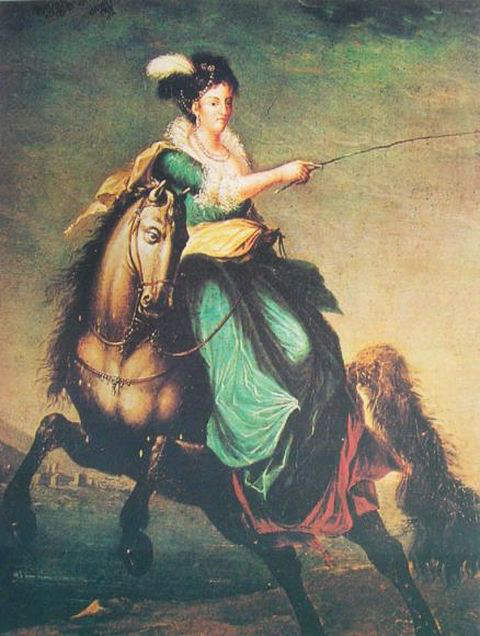
Equestrian portrait of Queen Charlotte of Portugal
Ornaments worn -
Double-strand pearl necklace.
Strands of pearls incorporated on the hairdo.
Pearl drop-earrings.
Portrait by - Unknown artist
Maria Leopoldina of Austria - First Wife of Pedro I of Brazil (Pedro IV of Portugal), Empress Consort of Brazil (1822-1826) and Queen consort of Portugal (March 10, 1826 to May 28, 1826)
Pedro I was the eldest surviving son of John VI and Charlotte of Spain. He was born in 1798, at the time John VI was the Prince Regent of Portugal, ruling on behalf of his mother who was insane. In 1801, when his elder brother Francisco Antonio died, Peter was made the Prince of Beira, as he was the second in line of succession to the throne, after his father, John, the Prince of Brazil. At the time the royal family left Portugal for Brazil, as an invading French army approached Lisbon in 1807, Pedro was just nine years old. The royal family would remain in Brazil for 13 years, and during this period, Rio de Janeiro became the capital of the Portuguese empire and Brazil attained the status of a kingdom. While Pedro was John VI's favorite child, his younger brother, Miguel was Queen Charlott'e favorite. Both Pedro and Miguel could not have a proper education, as they were brought up outside Portugal, and would often run away from the tutors, and play around with children on the streets of Rio. Thus, the two sons grew up not as royal children, but as any other common child in downtown Rio.
In 1817, Pedro married Archduchess Maria Leopoldina of Austria, a daughter of Francis II, Holy Roman Emperor. Pedro was 19 and Maria 20 at the time of their marriage. Maria was highly cultured, fluent in six languages, and a student of the natural sciences. Soon after she settled in her new homeland Brazil, she invited several natural scientists from Austria to study the fauna and flora of Brazil. The marriage produced seven children out of whom four survived into adulthood. It was her 8th pregnancy in 1826 that led to her death following a miscarriage.
In 1821, King John VI returned to Lisbon, but the Crown Prince Pedro chose to remain in Brazil with Maria Leopoldina and their children, as the Governor of Brazil. In September 1822, Crown Prince Pedro declared the independence of Brazil from Portugal, urged by Maria Leopoldina. Pedro was proclaimed Emperor of Brazil on October 12, 1822, on his 24th Birthday, and crowned on December 1, 1822, and Maria Leopoldina became Brazil's first Empress Consort. When King John VI died on March 10, 1826, Pedro inherited the Portuguese throne as King Pedro IV, while remaining Emperor Pedro I of Brazil. Maria Leopoldina thus became both Empress consort of Brazil and Queen consort of Portugal from March 10, 1826 to May 28, 1826, when Pedro I abdicated the throne of Portugal in favour of his seven-year old daughter, Maria da Gloria.
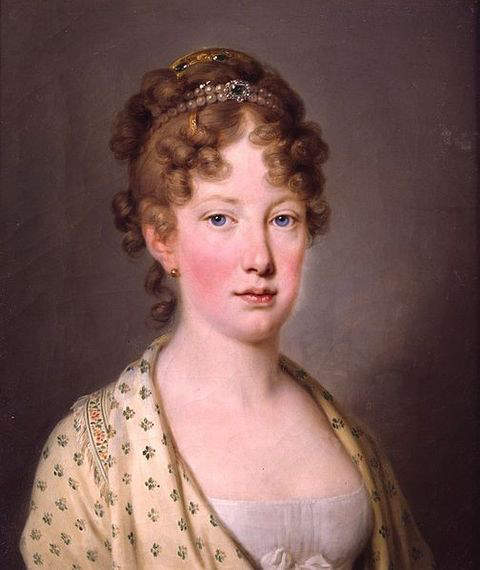
Maria Leopoldina of Austria - Wife of Pedro I of Brazil, Empress consort of Brazil and Queen consort of Portugal
Ornaments worn -
Headband consisting of two strands of pearls and a colored stone centerpiece.
A second head ornament behind the band, set with colored stones.
Earrings with a single spherical pearl.
Portrait by - Josef Kreutzinger in 1815
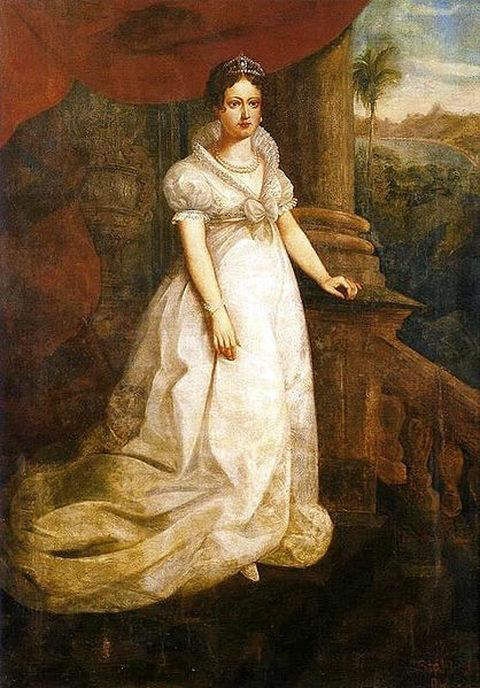
Portrait of Maria Leopoldina - Wife of Pedro I and Empress consort of Brazil
Ornaments worn -
Tiara set with pearls and colored stones.
Double-strand pearl necklace.
Pearl drop-earrings.
Double-strand pearl bracelet.
Portrait by - Luis Schlappriz
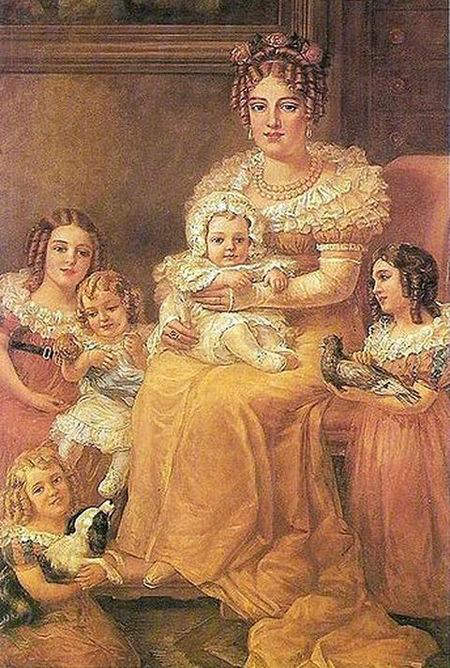
Portrait of Maria Leopoldina with her children
Ornaments worn by the Empress -
Pearl drop-earrings.
Double-strand pearl necklace.
Portrait by - Domencio Failutti in 1921
Amelia of Leuchtenberg - Second wife of Pedro I of Brazil and Empress consort of Brazil from 1829 to 1831
On October 17, 1829, Pedro married his second wife, Princess Amelie de Beauharnais von Leuchtenberg, the daughter of Eugene de Beauharnais (the son of Empress Josephine and her first husband Alexandre de Beauharnais, and the stepson of Napoleon Bonparte) and Princess Augusta Amelia, daughter of Maximillian I, King of Bavaria, and sister of Charles Auguste Eugene de Beauharnais, who later married Queen Maria II, after her marriage to Don Miguel had been annulled. It is said that Emperor Pedro I, enchanted by the beauty of Princess Amelia created in her honour, the Imperial Order of the Rose. The marriage turned out to be a happy one, producing a daughter Princess Maria Amelia of Brazil. When Emperor Pedro I abdicated the throne of Brazil in April 1831 and returned to Portugal via Britain, Empress Amelie followed her husband, and landed in the Portuguese Azores with her daughter. She remained in the Azores with her daughter, while her husband led an assault against his brother Miguel's forces, landing an invasion force in northern Portugal near Porto, in July 1832. She joined her husband in Lisbon, in April 1834, after Liberal forces successfully captured Portugal and the war ended. She entered the Palace of Queluz, where her husband finally took up residence. Unfortunately, her husband died a few months later in September 1834, of tuberculosis, at the relatively young age of 35. After the death of her husband Princess Amelia, dedicated herself to charities, and took care of her only daughter Princess Maria Amelia of Brazil, who unfortunately died of tuberculosis. Princess Amelia herself lived long and died in Lisbon at the age of 61, on January 26, 1873.
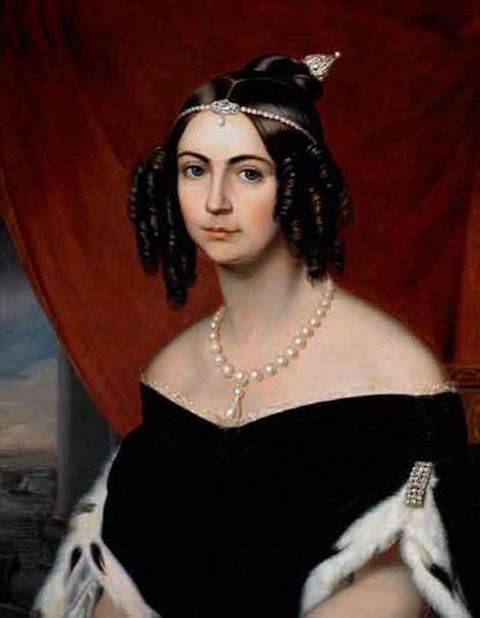
Amelia of Leuchtenberg - Second wife and Empress consort of Pedro I of Brazil
Ornaments worn -
Single-strand pearl necklace with large spherical pearls and a large drop-shaped pearl as centerpiece.
Single-strand of pearls as a band around the head, with a centerpiece carrying a drop-shaped pearl on the forehead.
A second hair ornament set with pearls.
Rectangular brooch set with three rows of pearls on the left side of her dress, just below the left shoulder.
Portrait by - Unknown artist after 1839
Appreciation of pearls by the spouses of the monarchs of the House of Braganza-Saxe-Coburg and Gotha from 1834 to 1910.
Queen Maria II of Portugal - Second Queen regnant of Portugal and the Algarves who ruled from 1826 to 1828 and again from 1834-1853
On April 26, 1826, King Pedro IV promulgated the liberal constitution of Portugal, but abdicated the throne of Portugal on May 28, 1826, in favour of his seven-year old daughter, Maria also known as Maria da Gloria, who became Queen Maria II of Portugal. The terms of the abdication also specified that when Queen Maria II came of age, she would marry Pedro's younger brother, Miguel. Pedro's younger sister Isabel Maria was appointed as regent to the young Queen Maria II. Initially, Miguel seemed to have accepted his elder brother's suggestion and decided to remain for another seven years until Maria da Gloria attained her majority.
However, under the influence of his ambitious mother Carlota Joaquina (Charlotte of Spain), Miguel appeared to have changed his mind, initially staking a claim for the regency in 1827, which was accepted, and in February 1828 returning to Portugal from exile in Vienna and apparently taking the oath of allegiance to the new Liberal Constitutional Charter and being installed as Lieutenant-General for King Peter IV, and Regent to Queen Maria II. Soon after taking office as the regent to Queen Maria II, Miguel's behaviour appears to have changed, purging liberal sympathizers from key positions and as Ministers of State, and replacing them with sympathizers of the absolute monarchy (Absolutists); dissolving the liberal dominated Cortes; and canvassing the support of the senate, the nobility and the clergy for the resumption of the absolute monarchy. On July 7, 1828, Miguel was proclaimed the absolute monarch of Portugal, setting aside the Liberal Constitutional Charter proclaimed by Pedro IV and Queen Maria II being effectively removed from the succession. Most of the Liberal elites and supporters went into exile, and most of Portugal recognized the sovereignty of the new monarch, except for the islands of Madeira and Terceira in the Azores. Liberal supporters who chose to remain in Portugal were persecuted by the absolutists (monarchists), encouraged by Miguel and the Queen dowager Charlotte. A Liberal Government in exile was set-up in Terceira in 1829, where the Liberals were able to keep the royalist forces at bay. By 1831, the Liberals had successfully taken most of the Islands of the Azores.
In April 1831, Pedro I abdicated the throne of Brazil in favor of his son, Pedro II, and sailed for Britain, where he organized a military expedition against his brother Miguel. Pedro I became the head of the Liberal Army, and from the Azores launched an assault on Northern Portugal, landing Liberal forces near Porto on July 9, 1832. Pedro's forces entered Porto and the city was soon beseiged by Miguel's army. The siege lasted over an year, with many failed assaults and battles. While under siege in Porto, Pedro took a risk and sent another epedition by sea to the Algarves in June, 1833, headed by the Duke of Terceira and John Napier. The Duke of Terceira disembarked in the Algarves, marched across the Alentego and fought with the royalist forces led by General Teles Jordao and captured Lisbon on July 24, 1833. Napier defeated and imprisoned a squadron in Cape St. Vincent and moving northwards along the Tagus, joined the Duke of Terceira. Thus, Portugal's big cities Lisbon and Porto came under the control of the Liberals, and the rural areas under the absolutists supported by the aristocracy and the peasants galvanized by the Church.
A stalemate then followed and during this period Maria da Gloria was proclaimed Queen of Portugal with Pedro as regent. Pedro dismissed all ministers and clergy appointed by Miguel, and appropriated all church lands and property. An attempt to besiege Lisbon failed and in October 1833, Miguel's royalist forces retreated eastwards towards Santarem. Miguel's ally in his attempt to reintroduce absolutism in Portugal was Don Carlos of Spain, who coincidentally was trying to regain the throne of Spain after his brother Ferdinand VII changed the rules of succession, enabling his daughter Isabella to succeed him. In April 1834, a Quadruple Alliance of Portugal, Spain, Britain and France agreed to banish both Don Miguel and Don Carlos from their respective countries in order to bring the civil wars in both countries to an end. Spain was required to commit troops to Portugal to bring the Liberal Wars to an end. Britain promised naval support for both Don Pedro and Isabella of Spain. The agreement signalled the end of the war, and Miguel agreed to go into exile, renouncing all his claims to the Portuguese throne. Pedro was finally successful in putting his daughter, Maria da Gloria back on the throne, and he finally retired to his former palace, Queluz, his place of birth, where he died of tuberculosis, at the relatively young age of 35.
After Maria da Gloria was restored to the throne of Portugal, her marriage to Miguel was annuled, and on January 26, 1835, at the age of 15, she was given in marriage to Auguste, Duke of Leuchtenberg, her stepmother, Amelia Leuchtenberg's brother. Unfortunately, Auguste died just two months after the marriage, on March 28, 1835. Nine months later, on January 1, 1836, Queen Maria da Gloria married Prince Ferdinand of Saxe-Coburg and Gotha who became the co-monarch of Portugal with the Queen. Prince Ferdinand was given the title of "King" in 1837, after the birth of their first child, Peter, who became the heir to the throne. Her reign as Queen was generally peaceful, except for an insurrection in May 1846 which was crushed by the army in February 1847. During her reign efforts were made to develop the standards of education throughout the country, and a public health act was enacted to curb the spread of cholera in the country. Between her marriage on January 1, 1836 and her death on November 15, 1853, Queen Maria gave birth 11 times, working out to one pregnancy every 1.5 years. In spite of warnings given by doctors of the dangers of constant prgenancies and births, that also killed her mother, Queen Maria continued to have children, until she died in 1853, while giving birth to her 11th child, who also died in the process. Out of the 11 children born, seven children survived into adulthood, and the eldest son Pedro, succeeded his mother, as Pedro V of Portugal in 1853, and the second son Luis, succeeded his brother Pedro, as Luis I in 1861.
Thus Queen Maria II's rule as the Queen-regnant of Portugal between 1826 and 1853 was interrupted by a period of six years, from 1828 to 1834, when her uncle Miguel II took control of Portugal as absolute monarch. The first part of her rule from 1826-1828, when her aunt Isabel Maria acted as regent for her, represents the continuation of the rule by the House of Braganza. However, the second part of her rule from 1834 to 1853, during which period she married Prince Ferdinand of Saxe-Coburg and Gotha, who became the co-monarch of Portugal, is considered by some historians as the beginning of a new dynasty, known as the House of Braganza-Saxe-Coburg and Gotha, to which the last four monarchs of Portugal belonged, ending with Manuel II, the "Patriot" or the "Missed King" who was deposed in 1910, and lived and died in exile in Great Britain.
Queen Maria II of Portugal - Second Queen regnant of Portugal
Ornaments worn -
The above portrait of Maria II of Portugal was probably drawn by an unknown artist, during her first tenure of reign as queen between 1826 and 1828, when she was between seven and nine years old. The young queen as depicted in this portrait does not seem to be wearing any ornaments.
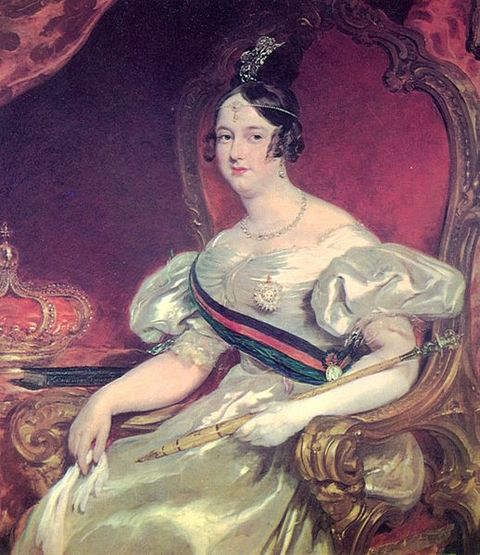
Queen Maria II of Portugal - during her second tenure as Queen regnant of Portugal from 1834 to 1853
Ornaments worn -
Single-strand pearl necklace.
Pearl drop-earrings.
Single-strand of pearls as a band around her forehead, and a drop-shaped pearl hanging from a centerpiece on the forehead.
Head ornament probably set with pearls and colored stones.
Circular brooch probably set with pearls.
Royal mace set with severl spherical pearls on its handle. pearls, placed atop a cushion on a table, by the right side of the Queen's chair.
Portrait by - Unknown artist around 1840
Stephanie of Hohenzollern-Sigmaringen - Wife and Queen consort of Pedro V, king of Portugal from 1853 to 1861
When Queen Maria da Gloria died in 1853, she was succeeded by her eldest son and heir to the throne, the Prince Royal Pedro, who ascended the throne as Pedro V of Portugal. Under his rule there was radical modernization of the Portuguese State and its infrastructure. Modern roads and railways were constructed, and telegraphic services introduced. Public health was also improved, but could not prevent the outbreak of Cholera in the latter part of his rule. Pedro V fearlessly visited hospitals during the cholera outbreak, handing out gifts and talking and comforting the sick. Unfortunately, the young king himself and his brother Ferdinand succumbed to the disease, which they themselves tried hard to control. The death of the much-loved king caused a revolt in many parts of Portugal, as the people could not come to terms with his sudden demise.
In 1858, five years after he ascended the throne, Pedro V, married Princess Stephanie of Hohenzollern-Sigmaringen, eldest daughter of Karl Anton, Prince of Hohenzollern-Sigmaringen and Princess Josephine of Baden. Both Pedro and Stephanie were around 21 years of age at the time of their marriage, but Stephanie was older to Pedro by two months. The marriage was a happy one, but unfortunately Queen Stephanie died an year later from Diptheria. The marriage was childless and after Pedro V died two years later, the throne passed to his younger brother, Luis I of Portugal.
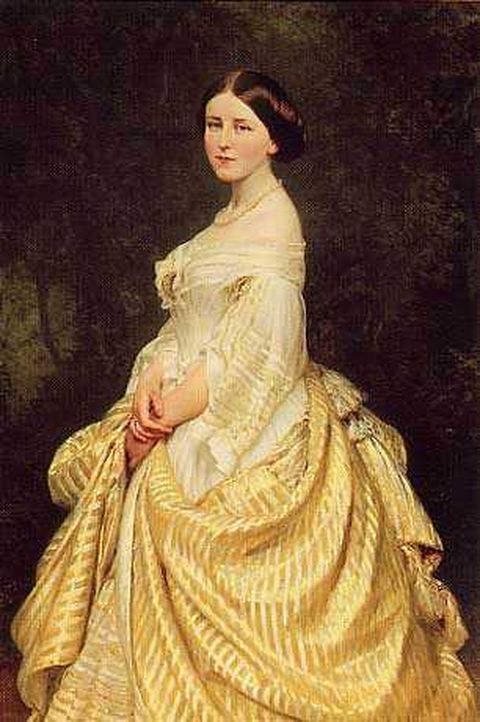
Stephanie of Hohenzollern-Sigmaringen - Wife and Queen consort of Pedro V, king of Portugal
Ornaments worn -
A double-strand pearl necklace
Portrait by - Unknown artist between 1850-1859
Maria Pia of Savoy - Wife and Queen consort of Luis I, king of Portugal from 1861 to 1889
Luis I, who was the second son of Queen Maria II and Ferdinand of Saxe-Coburg and Gotha, ascended the throne of Portugal after the death of his elder brother and King, Pedro V, who died without an heir, in 1861, of the cholera epidemic that hit Portugal during this period, at the relatively young age of 24 years. Luis, a man of culture and the sciences had a passion for Oceanography, and invested heavily in funding research to collect and study new specimens in the oceans of the world. He established one of the first aquariums in the world in Lisbon, named as Aquario Vasco da Gama, which is still open to the public, with its vast collection of maritime life forms. His reign lasted for 28 years until 1889.
In October, 1862, one year after he ascended the throne, Luis I, married Princess Maria Pia of Savoy, daughter of Victor Emmanuel II, king of Italy, and his wife Adelaide of Austria. The marriage produced four children out of whom two were still born, and two survived into adulthood. The eldest Don Carlos succeeded his father King Luis on October 19, 1889, as Carlos I of Portugal. Maria Pia was well known for both her extravagance as well as charity. When the Portuguese Parliament questioned her extravagance she is reported to have replied famously, "if you want a queen, you have to pay for her." However, Maria Pia was also well known in Portugal for her charity, and was known as the "angel of charity" or "mother of the poor" for her compassion towards the poor and the needy, and her devotion to charitable causes.
After King Luis I died on October 19, 1889, Maria Pia became the Queen dowager, and continued to engage herself in charitble activities and social projects. The Queen dowager was totally devastated by the assassination of her son King Carlos I of Portugal and her grandson Luis Filipe, the Duke of Braganza, on February 1, 1908. The deposition of her other grandson, Manuel II of Portugal, during the October 1910 revolution, that led to the establishment of the First Portuguese Republic, also deeply upset the Queen dowager. Maria Pia finally left Portugal with the rest of the royal family to exile in 1910. She returned to her native Italy, where she died on July 5, 1911.
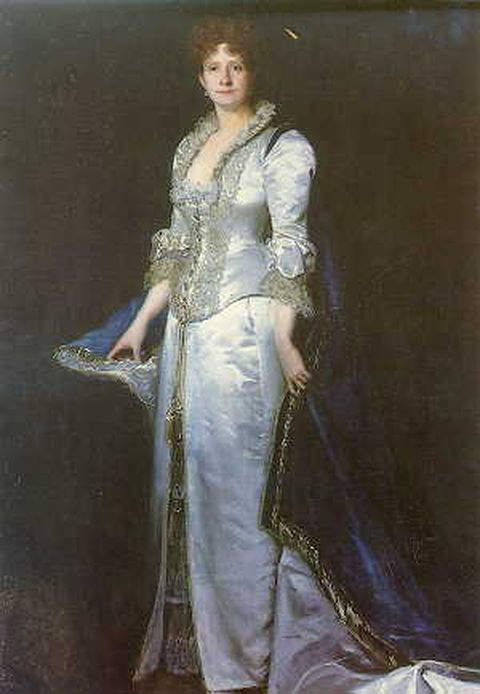
Maria Pia of Savoy - Wife and Queen consort of Luis I of Portugal
Ornaments worn -
In the above portrait of Queen Maria Pia of Portugal, painted by Emile Auguste Carolus-Duran in 1880, the Queen does not seem to be wearing any ornaments except for a pair of pearl drop-earrings.
Amelie of Orleans - Wife and Queen consort of Carlos I, king of Portugal from 1889 to 1908
Luis I died on October 19, 1889 at the age of 51 years. He was succeeded by his eldest son and heir to the throne, Prince Royal Don Carlos, who ascended the throne, as Carlos I of Portugal. As Prince Royal he had an intense education, preparing him for his future role as a constitutional monarch. His education was further enhanced by his travels abroad, to countries such as England, France, Germany and Italy, that served to update his knowledge, on the modernization taking place in those countries. He also gained some first-hand experience on the art of ruling, when in 1883, 1886 and 1888, he had the privilege of ruling as regent for his father, during his absence from the country, when he was travelling in Europe.
On May 22, 1886, the Prince Royal Carlos married Princess Amelie of Orleans, the eldest daughter of Philippe, comte de Paris and his wife Princess Maria Isabelle of Orleans. Carlos was 23 and Maria Amelia 21 at the time of their marriage. The marriage turned out to be a happy one, producing two surviving children, Luis Filipe, the Duke of Braganza and heir to the throne, who was assassinated together with his father, on February 1, 1908, and Manuel, who ascended the throne of Portugal after the assassination of his father and elder brother, and who was subsequently deposed in 1910, during the October Revolution.
Queen Amelie had a calm and mild disposition and became very popular amon the people. She learned Portuguese, and took an active part in social projects and charitable activities. Her other interests included literature, opera and theatre. She also acted as regent to her husband during his absence from the country. When Luis I, her father-in-law died on October 19, 1889, her husband ascended the throne of Portugal as King Carlos I, and she became the new Queen consort of Portugal. This was a period when the popularity of the Portuguese monarchy was on the decline, due to the economic problems faced by the country, leading to industrial disturbances and social unrest, and the popularity of the republicans and socialists who openly called for the abolishment of the monarchy increased. In 1907, as political unrest in the country increased, King Carlos responded by dissolving parliament, and authorising the Prime Minister Joao Franco to from a parliamentary dictatorship until order was restored in the country.
February 1, 1908 turned out to be a fateful day for the royal family of Portugal. On that day the family was returning from the palace of Vila Vicosa to the palace of Necessidades in Lisbon. They travelled first by royal train to Barreiro, and then took a boat to cross the Tagus river, disembarking at Cais das Colunas, in downtown central Lisbon's main square, Terreiro do Paco. The family then travelled by open carriage to the palace of Necessidades, and had to cross the square before enteing Arsenal Street. While the carriage was crossing the square, shots were fired from the crowd, by at least two gunmen, later identified to be republican activisits. The King died immediately, and his eldest son and heir, Luis Felipe was mortally wounded. The second son Prince Manuel was hit in the arm, and Queen Amelie miraculously escaped injury. The two assassins were killed on the spot by the police and the king's bodyguards. Prince Royal Luis Filipe was taken to the nearby Navy Arsenal, where he died about 20 minutes later. Several days later, the younger son, Prince Manuel was proclaimed the new king of Portugal
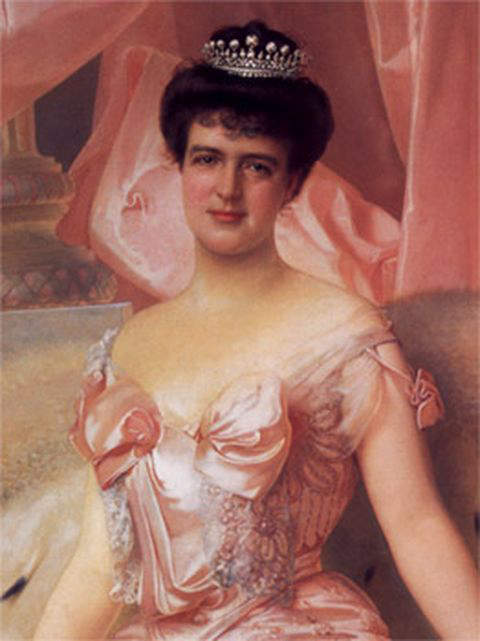
Amelie of Orleans - Wife and Queen consort of Carlos I, king of Portugal
Ornaments worn -
In the above painting of Amelie of Orleans by Vitor Corcos in 1905, except for the tiara, the Queen apparently is not wearing any jewels or ornaments.
Augusta Victoria of Hohenzollern - Wife of Manuel II, the last king of Portugal from 1908 to 1910, whom she married in 1913 after he was deposed as king
After the assassination of King Carlos I and the Prince Royal Luis Felipe, Prince Manuel the second son of the king, ascended the throne as King Manuel II of Portugal. He was 19 years old at the time he ascended the throne. The young prince received a broad-based education,that not only included the study of languages, literature, history, mathematics and music, but also physical training such as horse riding, fencing, rowing, tennis and gardening. The young prince then entered the Portuguese Naval Academy to prepare for a career in the navy, but this was abruptly terminated, when he was proclaimed the new king of Portugal, soon after the assassination of his father and elder brother.
The young king took immediate steps to bring about national reconciliation, by removing the hated Joao Franco, and forming a government of national unity, presided by Admiral Francisco Joaquim Ferreira do Amaral. The young king took meaningful steps to bring the monarchy closer to the people, by visiting different areas in the country, meeting his subjects and listening to their problems. Subsequently, the king would attempt to woo the socialists away from the Republican party, an attempt that was partially successful. The king also visited Spain, France and the United Kingdom, and adopted a pro-British foreign policy. In spite of all efforts by the king to bring about political stability, seven governments were established and fell within a period of 24 months. The Republican Party continued to gain ground, while the monarchists were loosing support. At this juncture, the murder of a prominent republican, provided the trigger for the eruption of unrest on the streets of Lisbon, that turned out to become a Republican revolution on October 4, 1910. Soldiers, civilians and municipal guards joined in, attacking loyal garrisons and the royal palace. The Palace of Necessidades, the official residence of Manuel II was bombarded, and the king immediately moved to the Mafra National Palace where he met his mother Queen Amelia and grandmother Maria Pia, and on the next day when it became clear, that the republicans had taken over the country, decided to embark from Ericeira, on the royal yacht "Amelia IV" for Oporto. The Royal family disembarked in Gibraltar after hearing that Oporto had fallen to the republicans. From Gibraltar the royal family went into exile in England, where they were received by King George V.
While living in exile in England, Manuel visited Switzerland in the Spring of 1912, where he met his cousin Princess Augusta Vitoria and was deeply impressed by her. In the following year, on September 4,1913, ex-king Manuel II married his cousin Princess Augusta Vitoria of Hohenzollern-Sigmaringen. The marriage ceremony was held in the Chapel of Sigmaringen Castle, presided by the Cardinal of Lisbon Jose Neto, living in exile in Seville. After the festivities that lasted two days, the couple went on their honeymoon to Munich. The marriage was a happy union that lasted until the death of the former king, but did not produce any children. Manuel II died in exile in London on July 2, 1932. His body was taken to Lisbon on August 2, 1932, on-board the British Cruiser HMS Concord, where it was interred in the Royal Crypt of the Braganza Dynasty in the Monastery of Sao Vicente de Fora, after a state funeral. The Portuguese monarchy and the House of Braganza from which the last series of kings originated, finally came to an end in 1932 with the death of the last monarch King Manuel II.
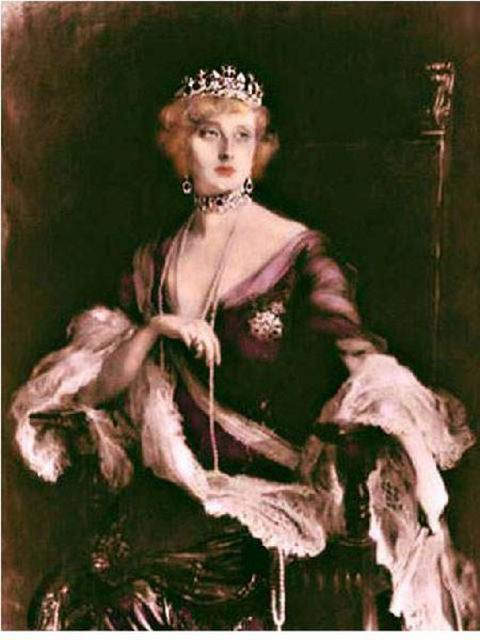
Augusta Victoria of Hohenzollern - Wife of Manuel II after he was deposed as king in 1910
Ornaments worn -
Choker necklace set with colored stones.
Drop earrings set with colored stones.
Brooch set with colored stones.
Tiara
Long rope of pearls hanging as a double strand from the neck of the princess.
Portrait by - Philip Alexius de Laszlo
The Use and Appreciation of Pearls by the Monarchies of Russia in the Middle Ages and until Modern Times
The use and appreciation of pearls by the monarchies of Russia in the middle ages and thereafter will be considered in detail in the next webpage - "History of the Discovery and Appreciation of Pearls -Page 10."
You are welcome to discuss this post/related topics with Dr Shihaan and other experts from around the world in our FORUMS (forums.internetstones.com)
Related :-
1) History of the discovery & appreciation of Pearls- Part 1
2) History of the discovery & appreciation of Pearls- Part 2
3) History of the discovery & appreciation of Pearls- Part 6
4) History of the discovery & appreciation of Pearls- Part 7
5) History of the discovery & appreciation of Pearls- Part 8
References :-
1) Amelie of Leuchtenberg - From Wikipedia, the free encyclopedia
2) Amelie of Orleans - From Wikipedia, the free encyclopedia
3) Augusta Victoria of Hohenzollern - From Wilipedia, the free encyclopedia
4) Catherine of Austria, Queen of Portugal - From Wikipedia, the free encyclopedia
5) Eleanor of Aragon, Queen of Portugal - From Wikipedia, the free encyclopedia.
6) Eleanor of Austria- From Wikipedia, the free encyclopedia.
7) Eleanor of Viseu - From Wikipedia, the free encyclopedia.
8) Isabella of Coimbra - From Wikipedia, the free encyclopedia.
9) Luisa of Guzman - From Wilipedia, the free encyclopedia.
10) Maria Anna of Austria - From Wikipedia, the free encyclopedia.
11) Maria Francisca of Savoy - From Wikipedia, the free encyclopedia.
12) Maria I of Portugal - From Wikipedia, the free encyclopedia.
13) Maria II of Portugal - From Wikipedia, the free encyclopedia.
14) Maria Leopoldina of Austria - From Wikipedia, the free encyclopedia.
15) Maria of Aragon, Queen of Portugal - From Wikipedia, the free encyclopedia.
16) Maria Pia of Savoy - From Wikipedia, the free encyclopedia.
17) Maria Sofia of Neuburg - From Wikipedia, the free encyclopedia.
18) Mariana Victoria of Spain - From Wikipedia, the free encyclopedia.
19) Philippa of Lancaster - From Wikipedia, the free encyclopedia.
20) Stephanie of Hohenzollern-Sigmaringen - From Wikipedia, the free encyclopedia
Powered by Ultra Secure
Amazon (USA) Cloud Network

Founder Internet Stones.COM
Register in our Forums
| Featured In
|
|
|
|
|
|
|
|

